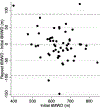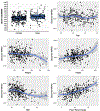Six-minute walk distance in healthy young adults
- PMID: 32308201
- PMCID: PMC7174378
- DOI: 10.1016/j.rmed.2020.105933
Six-minute walk distance in healthy young adults
Abstract
Background: The 6-min walk test (6MWT) is a commonly used clinical assessment of exercise capacity in patients with cardiopulmonary or neuromuscular disease, but normal values are lacking for young adults, who are frequent subjects of testing.
Methods: In a two-center study, 272 young adults, ages 18-50, underwent American Thoracic Society protocolized 6-min walk testing, and 56 underwent repeat testing. A linear regression model was developed based on anthropomorphic data. This model was compared to existing prediction equations.
Results: Median 6MWD for the cohort was 637 m (IQR 584-686 m) and was not significantly impacted by age. This is in contrast to existing equations extrapolated from older subjects that predict increasing 6MWD in younger subjects. We found weak correlation of 6MWD with height, weight, BMI, and resting heart rate. Heart rate at completion correlated most strongly with 6MWD (rho 0.53 p < 0.0001). Repeat 6MWD was surprisingly variable, with a median difference between tests of 32.5 ± 31.9 m. Established reference equations performed poorly in this population, largely because age has much less effect on 6MWD in this group than in older adults.
Conclusions: Established reference equations should be reconfigured to include data from young adults, as age has minimal effect on 6MWD in this population. Heart rate response may be a valuable measure of effort in normal subjects. Six-minute walk distance, as with pulmonary function and exercise testing, should have predictive equations across the spectrum of age to allow for accurate assessment of exercise limitation.
Keywords: Cardiorespiratory fitness; Exercise test; Reference values.
Copyright © 2020 Elsevier Ltd. All rights reserved.
Conflict of interest statement
Declaration of competing interest SJH reports no conflicts of interest. ARH has served as a consultant to Actelion, Bayer, GSK, Accleron, United Therapeutics and Pfizer. She has received research/grant support from the NIH and Cardiovascular Medical Research and Education Fund. ELB has served as a consultant for Hovione Pharmaceuticals.
Figures




References
-
- Kadikar A, Maurer J, Kesten S. The six-minute walk test: a guide to assessment for lung transplantation. The Journal of heart and lung transplantation : the official publication of the International Society for Heart Transplantation. 1997;16(3):313–319. - PubMed
-
- Cahalin L, Pappagianopoulos P, Prevost S, Wain J, Ginns L. The relationship of the 6-min walk test to maximal oxygen consumption in transplant candidates with end-stage lung disease. Chest. 1995;108(2):452–459. - PubMed
-
- Martin C, Chapron J, Hubert D, et al. Prognostic value of six minute walk test in cystic fibrosis adults. Respiratory medicine. 2013;107(12):1881–1887. - PubMed
Publication types
MeSH terms
Grants and funding
LinkOut - more resources
Full Text Sources

